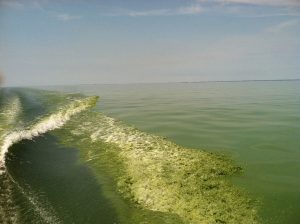GREAT LAKES SCIENTIST SAYS, “IF WE LOSE THE EPA, WE LOSE LAKE ERIE”
Lake Erie is the smallest of the Great Lakes by volume, and yet it has the highest population living along it’s shorelines, which makes it more vulnerable to pollution and many other problems than the rest of the Great Lakes.
The Canadian province of Ontario as well as the states of Ohio, Pennsylvania, New York and Michigan share its shoreline. Nearly 12 million people get their drinking water from Lake Erie.
Its primary inlet is the Detroit River.
Lake Erie is important not just for its drinking water, beaches, swimming and boating, but for its fish. The number of anglers on Lake Erie is greater than any other of the Great Lakes.
The lake, unfortunately, is famous for getting so polluted in the late 1960’s, one of its tributaries caught fire. The incident helped lead to the formation of the EPA, the Clean Water Act and other regulatory agencies and regulations.
Over the past fifty years, there have been incredible improvements to the quality of Lake Erie, but the scientists at the conference admitted they were concerned about some of the old issues that led to Lake Erie’s pollution returning once again without constant research, monitoring and regulations.
The Threat of Algal Blooms and Invasive Species

Algal bloom in Lake Erie, courtesy of NOAA
One of the biggest threats the scientists are worried about, and what received the most attention: algal blooms. They are caused by an influx of phosphorous run-off from farms that use fertilizers and manure. The eastern portion of Lake Erie is often slimy with the bright green mess. But it isn’t just ugly, say these experts. It can kill plant life and fish and even lead to liver damage.
Another big concern: invasive species like Asian carp, zebra and quagga mussels and round gobies, which are affecting fishing and Lake Erie’s shoreline.
A Massive and Significant Loss of Ice
What was alarming to many of the scientists: the rate of the loss of ice on all the Great Lakes. Bowling Green State University’s Dr. Robert Michael McKay, a Ryan professor of biology revealed at the conference that there has been “ a 75 percent decline in ice on the Great Lakes over the past fifty years.” Dr. McKay tells Great Lakes Now, “It is significant and it parallels the declines in ice cover we’re seeing in the Arctic at present as well.“

Dr. Robert Michael McKay, courtesy of Mary Ellen Geist
Dr. McKay says what many people don’t realize is that ice cover provides physical protection for fish and fish eggs, and protects shorelines from erosion, too.
Dr. McKay says, “We are seeing an increase in the frequency of very low ice on Lake Erie and the Great lakes in general, and lack of ice cover results in a major shift in the food web.”
So why is it happening? Dr. McKay says, “It’s consistent with what humans have been doing to their environment since the beginning of the industrial age: excess greenhouse gases in the atmosphere. “
H.R. 861, The Bill that Would Terminate the EPA
But perhaps most startling, said keynote speaker Dr. Jeff Reutter, special advisor for the Ohio Sea Grant program, is the threat to the future of Lake Erie from the potential dissolution of the agency that watches over the U.S. environment and creates regulations to protect it.
The bill, called H.R. 861, introduced to the 115th Congress by Florida Republican Congressman Matt Gaetz on February 3, 2017, calls for the termination of the Environmental Protection Agency.
Dr. Reutter said, “If we lose the EPA, we lose Lake Erie”.
Dr. Reutter directed the Ohio Sea Grant program starting in 1987. He retired in 2015. He’s been working on Lake Erie since 1971. He tells Great Lakes Now he’s worried about the future of the lake.
He says, “Right now, excessive nutrient loading is causing three problems in Lake Erie:
harmful algal blooms in the Western Basin; a dead zone – an area of zero oxygen – at the bottom of the central basin between Pelee point and Long Point; and then in the Eastern basin, excessive growths of cladophora.”
He blames agricultural run-off for the problems, but he says phosphorous can come from other sources, too. He says “the algae don’t care where the phosphorous comes from”. He says, in 2013, 2000 people living near the Lake Erie watershed were forced to stop drinking their water due to toxic levels of phosphorous and in 2014, the city of Toledo – about 400 thousand people – were also forced to stop drinking their water for the same reason.
Dr. Reutter says without regulations from agencies like the EPA and constant monitoring and vigilance from scientists, Lake Erie will suffer and could return to pollution levels of decades ago.
The dozens of presentations at the meeting over a three-day period, called “Status of Lake Erie: Understanding the Nearshore and its Connections” were the result of three to four years of research from Environment and Climate Canada, The U.S. EPA’s Research Lab in Grosse Ille, Michigan, and the Ohio Sea Grant/F.T. Stone Lab at Ohio State.







Follow Us!